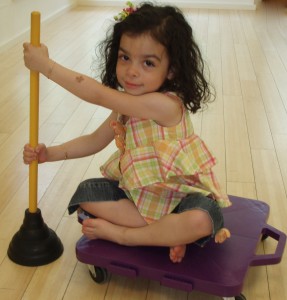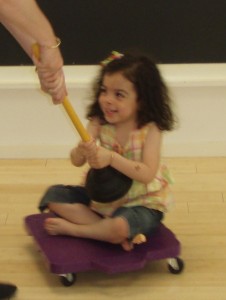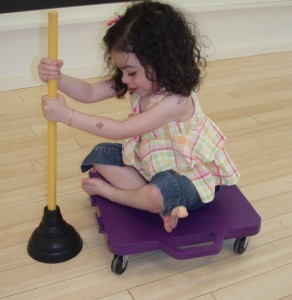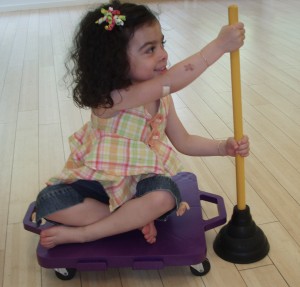It is always fun to see the reaction of children when I pull out a plunger to play with. Even at a very young age, children acquire a sense of place – and plungers belong in the toilet, certainly not in the gross motor room. After I assure them that the plunger I use has NEVER seen a toilet, I introduce the many ways one can have fun with a plunger. I share them below.
Benefits of the Activity:
- There is a motor planning and spatial demand (right side/left side) to figuring out how to move the body correctly. If the child cannot do this independently (and many children can not), then give additional verbal cues as to where the hands should be placed. Frequently you have to place the child’s hands correctly if s/he cannot figure this out independently.
- This is a “heavy work activity,” which helps to calm and organize the child. Along with providing great sensory input, the action requires work from the core muscles, so it’s great for physical fitness as well.
- An added component is a lot of trunk rotation and midline crossing. These help with all aspects of physical development and good communication in the brain.
- These activities challenge motor skills from very simple, passive input to complex motor sequencing.
Directions:
1. Have the child hold the dowel with two hands while sitting on a scooter.
2. Move the child around. For kids with low tone or poor postural control, the movement needs to be slow and directional shifts carefully graded. Extra support may need to be provided as direction of the movement changes.
3. For children with better control and craving stimulation, whip them around in various directions, pile up pillows or mats and let them crash into the pile. This stimulates proprioceptor and kinesthetic nerves, which in turn activate organizing parts of the brain. If done quickly, the motion also stimulates the vestibular system; another organizing system for the brain.
- Adding “Get Ready, Get Set, Go!” activates the auditory (hearing) and language centers.
- The child should prepare for the crash by using the eyes to guide the crash.
4. Next challenge is to “Row the Scooter” with the plunger. The child holds the plunger in two hands and presses it into the floor a few inches in front of the scooter. While sitting crossed legs on the scooter, the child then pulls self forward with this motion. It is repeated until the child reaches a specified destination. This is a motor planning challenge, because the child needs to figure out how to push downward into the floor while simultaneously pulling the scooter forward.
5. Once the child masters this motion, have the child place the plunger to the side, alternating right and left. The contralateral hand, or the one reaching across the body should be positioned on the top, giving adequate force to the push off. This translates into a fairly complicated motor sequence-each cross over requires a change in hand position. As the motion because more fluid, the child should glide across the room.
6. Add an added challenge to any of these methods: retrieve puzzle pieces, a ball, play modified games such as soccer, bean toss or kickball using the plunger and scooter to move rather than running.
Special Considerations:
- Be sure to purchase a NEW plunger and dedicate it to the scooter activity. Make sure to label it to ensure that it is not accidentally used in the bathroom!
- For children with very low core strength, these activities should be introduced very gradually. While a lot of fun, without adequate motor coordination, they can be quite demanding, frustrating and for some even scary!



